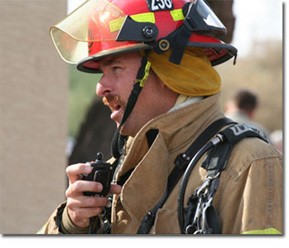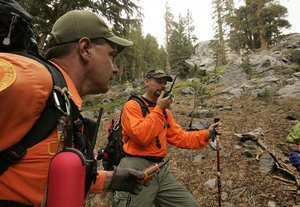Communicating to support the needs of L.C.E.S. involves two components, the HOW and the WHAT.
HOW
HOW we communicate is a reflection of what environment you are in with what type of equipment.
Failure to adequately communicate the key responder safety considerations will have a direct impact on responder safety so redundancy is critical!
- Radios, whistles, proactive lights, handwritten words (pen/paper), tag lines and speaking face-to-face are some of the more common forms of responder communications.
- The methods that will be relied on should be clearly communicated so that each Team member knows where and how they should expect to receive safety messages.
To reduce the chance of a communication failure, always provide for a backup method of communication.
Redundancy Example #1

The Team is made up of members from multiple organizations that do not have radios that are interoperable (they don't have the same channels needed to communicate).
Because of the area they will be working in is small, the Team leader instructs all members to speak to each other face-to-face (line of sight).
This is also the lowest form of technology and more reliable and resilient than using technology to communicate.
Since L.C.E.S. is a tactical consideration at the squad level, the lack of radio communications does not generally pose the same challenge as not having radio communications across the entire response.
Redundancy Example #2

Rich Pedroncellli/AP Photo
The Team will be spreading out across a large wooded area to search for Little Timmy.
Because there are other search teams in the area, the Team leader of Squad 3 instructs all members to use Tactical Channel 08 for their intra-squad communications.
With this example, it is important that at least one person on the Team has a radio set to the incident wide radio channel for use in communicating back and forth with their base command.
WHAT
WHAT we communicate is the content of the message, particularly emergency messaging like a notice to evacuate.
- Communication to team members during an active incident should include a wide safety margin to insure that all members receive the intended information in a timely fashion in order to make the needed adjustments or perform the needed actions.
- If an evacuation is ordered, earlier notice is better than late notice so that the affected responders can walk and not run to the safety zone.
Other considerations to be included in L.C.E.S. Communication are:
- Known safety concerns (i.e. energized power lines)
- Known and anticipated incident conditions (i.e. structural condition)
- Known and anticipated environmental conditions (i.e. weather)
- Contingency plans (i.e. if radios go down, if Team member is injured, etc.)
- L.C.E.S. is not merely an acronym, each element needs to be applied to the situation (i.e. "John is the Lookout", "Safety Zone is under THAT tree"; not merely a recitation of what L.C.E.S. means!)
NOTE: It is important to note that L.C.E.S. is only part of a field Team Briefing. Briefing's are a more comprehensive component of response communications and are explained and explored in greater detail in the Briefing and Debriefing Course.
Some of those additional briefing topics include:
- Strategy and tactics to be used
- Job assignments (duties)
- Duration of assignment
- Political considerations
- Radio frequencies
- Gut feelings about the situations, the assignment, or individuals
Common Language
In relaying an emergency message, a common language is the most critical.
Common language refers to deciding and communicating what sounds, words or images will be used to relay messages, including emergency messages, to all incident responders.
For instance, in USAR Operations, the number of whistle blasts or horn honks indicate the following:
1 (one) LONG blast = cease operations
1 (one) LONG and 1 (one ) SHORT blast = resume operations
3 (three) SHORT blasts = immediate evacuation
By communicating the expectations of these potential tones in advance, it enables all responders to know what actions are and are not expected of them whenever or wherever they may hear them.
